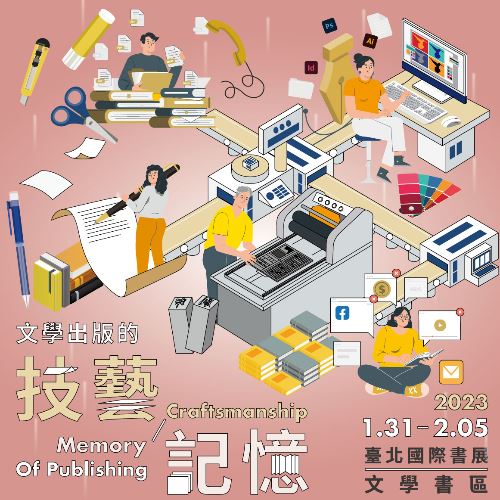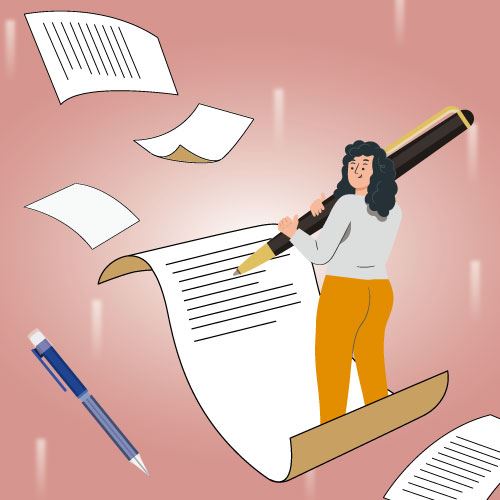The Role of an Editor
In earlier times, manual copyediting demanded the full attention of professional editors, and it was their responsibility to ensure all was in order prior to printing. Today, editors must also be competent communicators and planners and have an eye for design aesthetics. A post several years ago on the Aditorwork social media fan page featured a 'periodic table' of all of the elements in the modern editor's job description. From developing and pitching new content proposals to creating book exhibition materials, editors today have a lot on their plate.
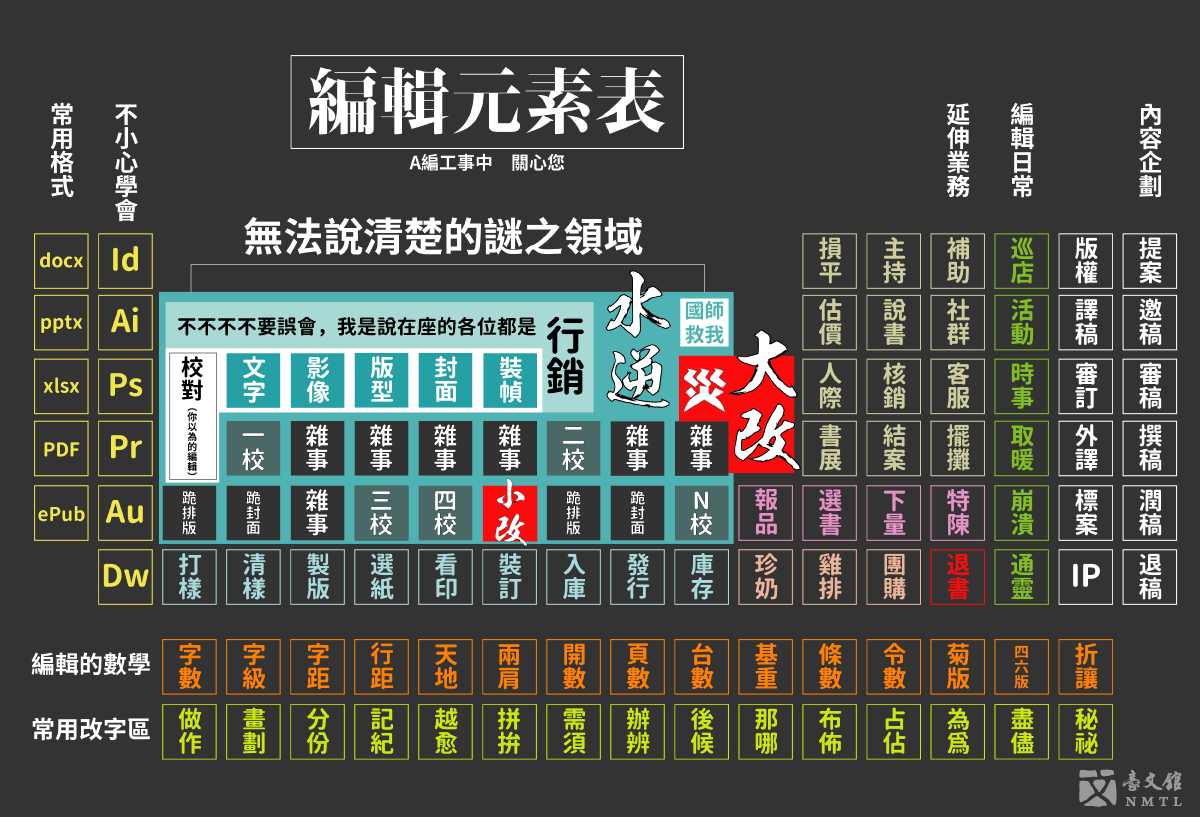
The Modern Editor's Table of Elements
provided by: Aditorwork
View from the Editorial Desk
Prior to the 1990s, computers were still largely absent from editorial desks. Traditional tools of the trade, including colored markers, utility knives, glue, and color-reference and font cards, shared desk space with a trusty phone (for communicating with authors, printers, and typesetters), fax machine, and unruly piles of papers and books, creating the instantly recognizable stage upon which editors worked their professional magic. After the dawn of computerization, however, editors added another essential item to their armory – nutritional supplements such as lutein to protect their eyes from the effects of long-term eye strain.
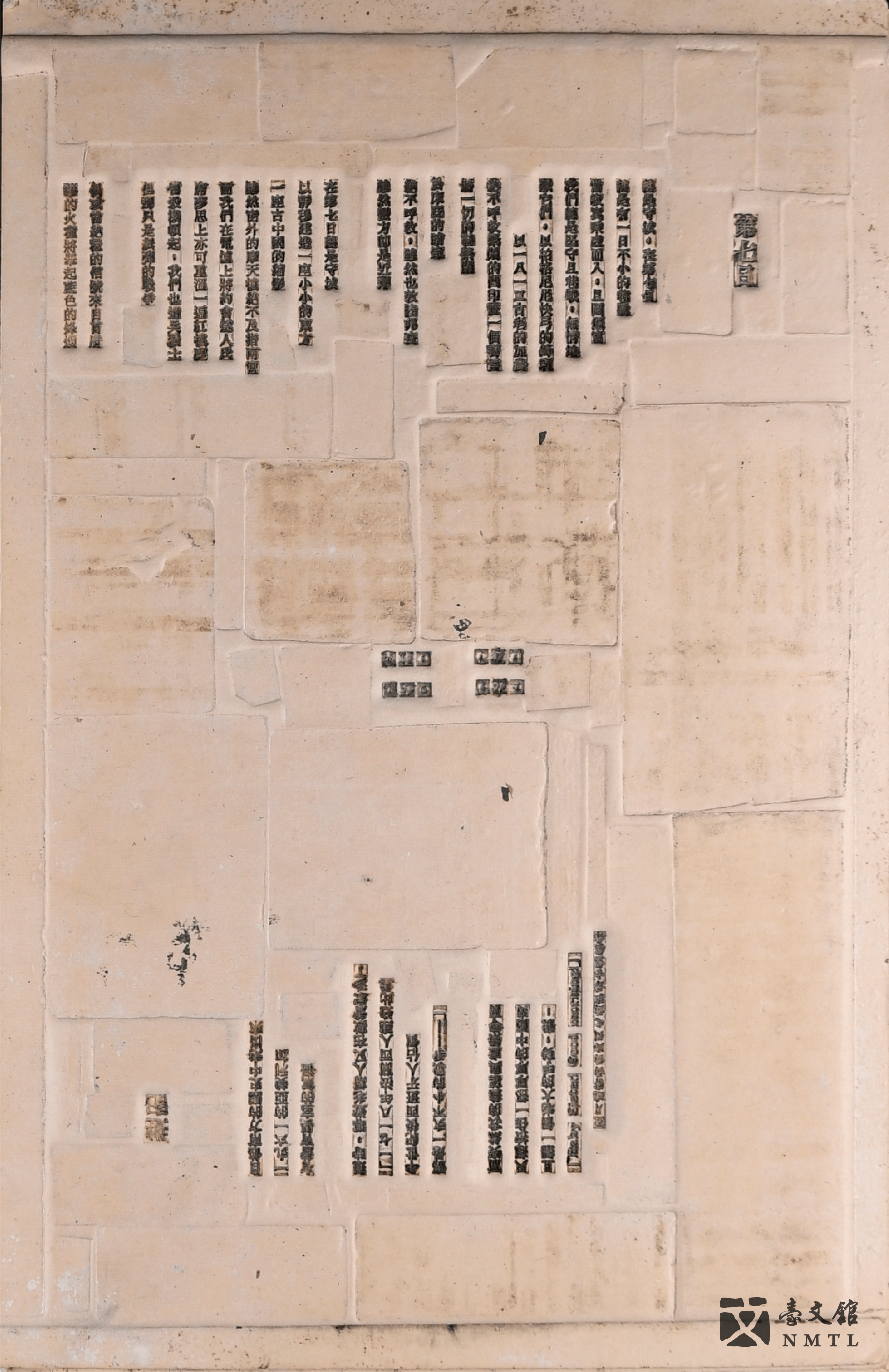
Wolf Smoke
In the not-so-long-departed era of movable-type printing, both to reduce the weight of printer plates and to speed up the printing process, plates would be framed to match the specific dimensions of a book's pages. These could either be retained for use in subsequent print runs or disassembled for reuse. This frame was used to print the second poetry compilation of the renowned Taiwanese poet Ming Hsiang entitled Wolf Smoke.(from the NMTL permanent collection)
Into a New Era: from Mechanical to Computerized Typesetting
Thoughts of the sorting room invariably take me back to late August 1993 and the day the newspaper fully
computerized. I visited our eerily empty second-floor typesetting operation. Wandering around,
I saw two workstations set with large-font type that pronounced: 'So Long and Farewell!'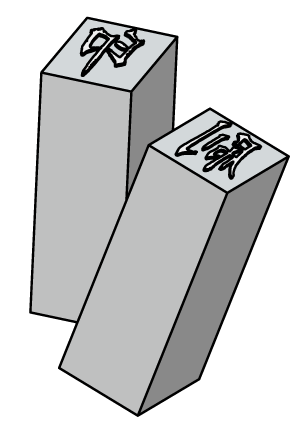
- from The Weightiness of Type by Ching-chuan Liu
(fmr. Supplements Chief Editor, Taiwan Shin Sheng Daily News)
With print houses switching en masse from manual to computerized typesetting, Er-Ya Press printed its final manually typeset book Age of Upheaval in 1993, while Hong Fan Publishing released its last manually typeset book The Compiled Essays of Xu Zhimo in 1997, capitulating to the times only after they could no longer find a manual typesetter. Publishers necessarily adjusted to the needs of this new approach to printing. Type casters, sorters, and other craftsmen tied to manual printing soon found themselves out of work.
Honoring and promoting Taiwan's printing heritage, Ri Xing Type Foundry in downtown Taipei City retains its casting molds, commercial printing equipment, and sorting room stocked with row upon row of cast metal sorts (type). Today, they occasionally create and promote limited-edition, manually typeset books to breathe new life and interest into this largely extinct industrial art form. One example is the mixed printed word and calligraphy work The Living Leaf Collection published by Ri Xing in 2019 in collaboration with author Ta-chun Chang.
Writing How I Speak: The Flowering of Mother-Tongue Literature
The advent of computerized typesetting and phonetic entry systems for Chinese and other characters significantly eased the editing process for 'mother-tongue' literature as well as paved the way for publishing significantly more global literature in translation, of which Avanguard Publishing's Chinese version of Le Petit Prince is an oft-cited example. Also, as part of promotions surrounding the release of the Hokkien translation of James Joyce's classic Dubliners in 2022, the Taiwanese translator held a book launch press conference in Ireland.
Formatting for Invisibility: Hong Fan's 'Gold Standard' of Publishing Excellence
Hong Fan Publishing's style, always clean, simple, and free of gratuitous adornment, dignifies the quality of the literature within and promotes reading enjoyment through crisp formatting and small-font, often odd-number-only page numbers. Unwavering commitment to the reader experience has won for Hong Fan a large and fiercely loyal fan base.
In his book Subterranean Homesick Blues, Shihfang Ma wrote:
On the issue of book 'appearance', I stand squarely in the conservative camp. In the old days of typeset printing, for works of modern Chinese-language literature, none did better than Hong Fan Literary Press. In today's age of computer typesetting, Hong Fan remains the best, now and always. Theirs is the perfectly 'invisible'template – a diaphanous presentation deftly delivered to bold effect, and a tribute to decades of purposeful effort. … This is particularly germane to works of literature. Templates should be as simple as possible. Beige or ivory-white wood-free paper is best, and the Ming typeface, bolding, and italics should be studiously avoided. At most, the imitation Song-style typeface may be used, with the total number of typefaces restricted to four. Furthermore, in line with Lu Xun's evergreen wisdom, plenty of space should be given in the lower and upper margins of each page. In the end, all of this skilled effort should be expended to achieve the quality of 'invisibility'.
The Art and Agony of Patience: Literary Excellence Cannot be Rushed
How long does it take to get a book to press … one month? Two? Three? … several years? … a decade? Editors invariably do all that is necessary to ensure each work is impeccably perfect before publishing.
Thinkingdom Media Group Editor-in-Chief Maudlin Yeh worked many years to secure author Tong-hao Lee's approval to republish his long-out-of-print work Breakup on the Silk Road, while Asia Culture Publishing's Chief Editor & Publisher Chih-feng Liao spent almost six years getting author Tien-chong Wei's Probing the Brambles: Thoughts on Reading to print. Whenever Chih-feng pressed him about how work on his manuscript was coming, Tien-chong would happily meet him for a lunch reliably bereft of any news of progress. Only after an untold number of these lunches did Asia Culture Publishing finally secure Wei's final draft of this now-essential work of Taiwan literature.
Remarkably, 18 long years separated the release of volumes 1 and 2 of the roundly acclaimed novel by Wen-hsing Wang Backed Against the Sea. This now-classic work could very well have remained uncompleted and forgotten but for the dedicated patience of its editor.
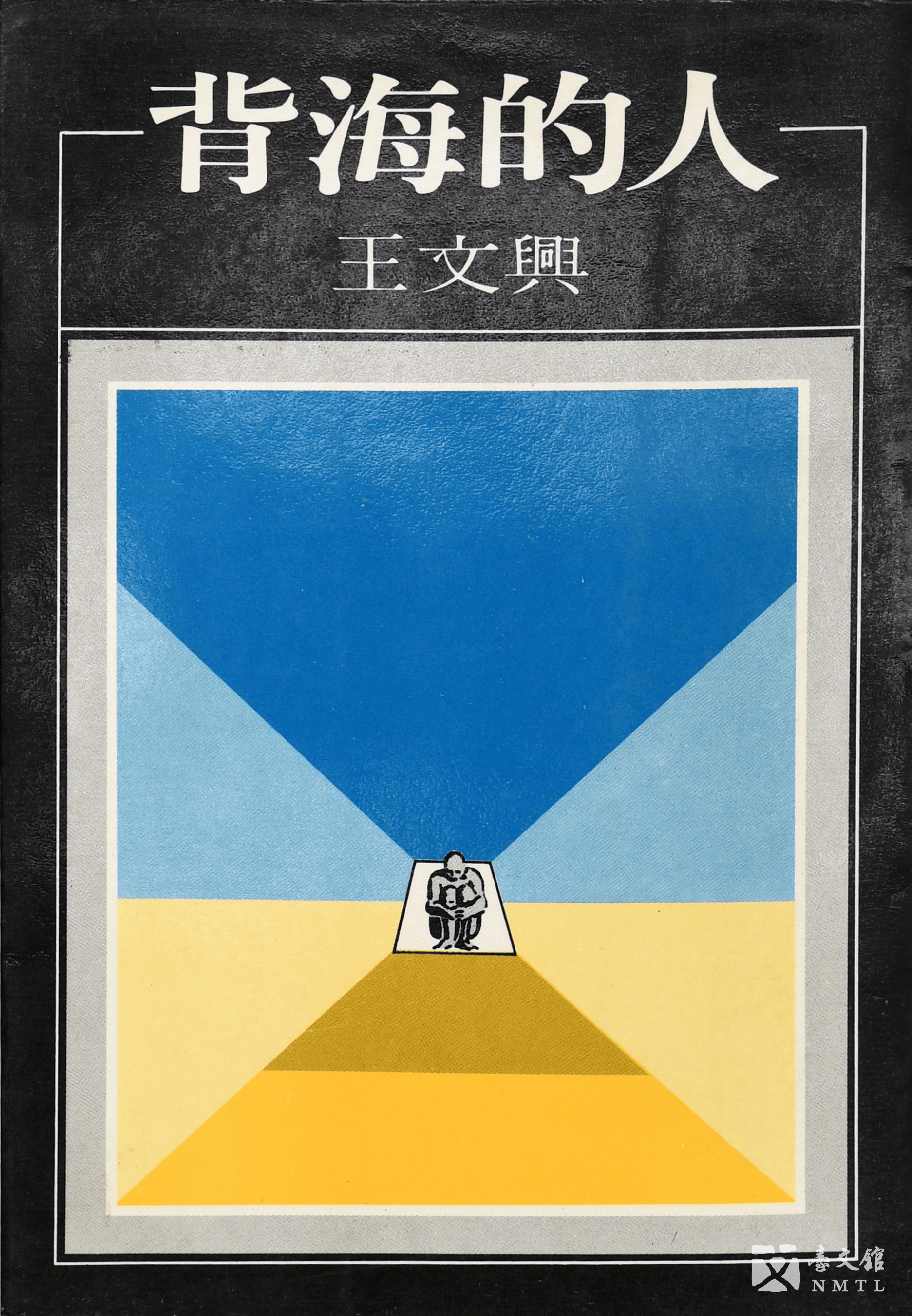
Backed Against the Sea - Wang, Wen-hsing
Vols. 1 and 2 of Backed Against the Sea were published 18 years apart.
from the NMTL permanent collection
A Beautiful Jacket: Good Design's Enticing Charms
The cover, often a reader's first impression of a book, is crucially important in attracting attention and interest. The cover design complements other aesthetic choices made related to layout, size, title page, and binding and may significantly add to a book's retail price. Thus, editors must coordinate closely with design professionals to ensure cover art achieves its desired impact. Of course, cover art has evolved with the times. Well into the 1970s, book cover art tended to reflect minimalist aesthetics and frequently featured blocks of color or scenes rendered in watercolor. The rising influence of commercialism and marketing from the 1970s forward led to the increasing use of color photographs and other professional design elements in cover designs. Over the years, some covers and book illustrations have earned recognition as works of art in their own right. Celebrated illustrator Animo Chen created super-wide dimension illustrations for Cheng Kuo's seven-volume novel series Legends of Mountains and the Sea reflecting the style of the panoramic Song-dynasty handscroll painting "Along the River During Qingming Festival". While standalone works of art on their own, these illustrations create a cohesive and beautifully flowing visual narrative when placed side by side.
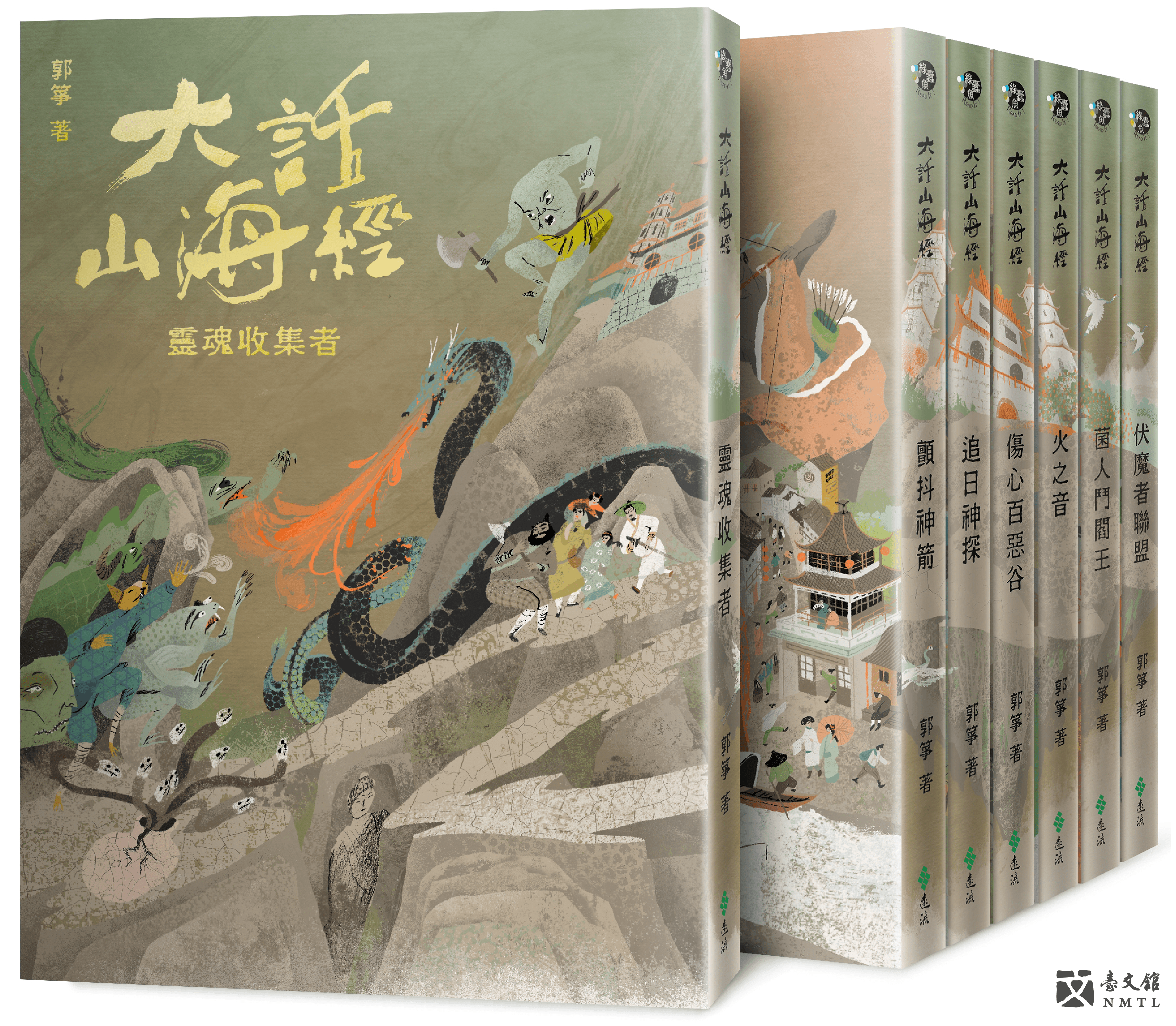
Legends of Mountains and the Sea – Kuo, Cheng
Each illustration is both a standalone work of art and one panel in an exquisite visual narrative.
provided by: Yuan-Liou Publishing

